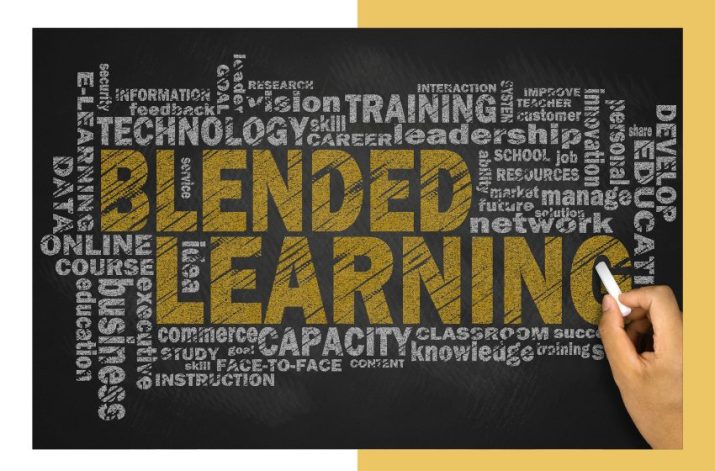LMS and Blended Learning: A Dynamic Training Mix
By Dumb Little Man
January 10, 2024

Companies constantly seek innovative methods to provide effective and efficient employee training in today’s fast-paced world. Blended learning has become increasingly popular as it combines the benefits of face-to-face instruction with the flexibility of learning. At the core of this approach is a Learning Management System (LMS), which enables the coordination and delivery of both in-person training programs. Let’s dive deeper into this training mix and discover how it can transform how organizations educate their workforce.
1. LMS: A Comprehensive Training Platform
A Learning Management System, known as an LMS, is a software application that allows organizations to manage, deliver, and track their training programs. It is a hub for all training-related activities, ensuring administration, documentation, and reporting. With an LMS, organizations can organize learning materials like videos, presentations, quizzes, and assessments in a structured and easily accessible format. This enables employees to access these resources at any time, from anywhere, thereby encouraging self-paced learning. Although many options are available, to find the best LMS for small business, use the Internet to understand your organization’s needs.
2. Blended Learning: The Perfect Combination
Blended learning, as its name implies, combines the best of both worlds: face-to-face instruction and online learning. This approach acknowledges learners’ preferences and learning styles that cater to their needs. Employees can participate in in-person workshops or seminars, virtual classrooms, online discussions, interactive e-learning modules, and more in a learning program. Organizations can ensure engagement and retention of knowledge by incorporating various learning methods.
3. Seamlessly Integrating LMS with Blended Learning
The strength of blended learning lies in its integration with a Learning Management System (LMS). An LMS acts as a bridge between virtual learning environments by facilitating coordination and delivery of training materials. With an integrated LMS, organizations can schedule in-person training sessions efficiently, manage registrations and enrollments, distribute e-learning modules, assign assessments, and monitor employees’ progress from one centralized platform. This seamless integration increases efficiency while reducing overheads so trainers can focus on delivering impactful training experiences.
4. Personalized Learning Paths
One of the benefits of using a learning approach with an LMS is the ability to create personalized learning paths for each employee. Organizations can curate customized learning journeys based on employees’ roles, skills, and developmental goals by utilizing the LMS as a hub for training materials. This tailored approach ensures that employees receive training when they need it most. This enhances employee performance and boosts motivation and engagement.
5. Real-time Monitoring and Tracking
An integrated LMS also allows organizations to monitor employee progress and track their performance in time. Trainers can access analytics and reports to gain insights into learners’ levels of engagement, completion rates, assessment scores, and more. By monitoring employee progress, trainers can quickly identify any knowledge gaps or areas that require improvement and take action to address them. This feature of an LMS guarantees that organizations can continually assess and optimize their training programs for effectiveness.
6. Flexibility and Accessibility
Blended learning powered by an LMS offers flexibility and accessibility to employees.
Unlike classroom-based training, blended learning allows employees to learn at their own pace and from any location. It enables learners to access training materials, participate in discussions, submit assignments, and receive feedback at their convenience. This aspect of flexibility is especially advantageous for geographically dispersed teams that might face challenges attending in-person training sessions.
7. Cost Effectiveness
Cost is always a factor for organizations when it comes to training. Blended learning reduces the need for in-person instruction, resulting in savings on travel expenses, accommodation costs, venue rentals, and other related expenditures. Moreover, integrating a Learning Management System (LMS) enables organizations to scale their training programs without incurring overhead expenses. Organizations can deliver training by adopting a learning approach powered by an LMS while maximizing their return on investment at a fraction of the cost.
Conclusion
Combining an LMS with learning offers organizations a training approach that combines the advantages of face-to-face instruction with the convenience and accessibility of online learning.
An LMS serves as a hub that facilitates the coordination and delivery of training materials. It also enables learning paths, real-time monitoring, tracking, and cost-effective training solutions. By utilizing this range of training resources, companies can revolutionize their training programs, empower their employees, and foster a culture of learning and development.
Dumb Little Man
At Dumb Little Man, we strive to provide quality content with accuracy for our readers. We bring you the most up-to-date news and our articles are fact-checked before publishing.



